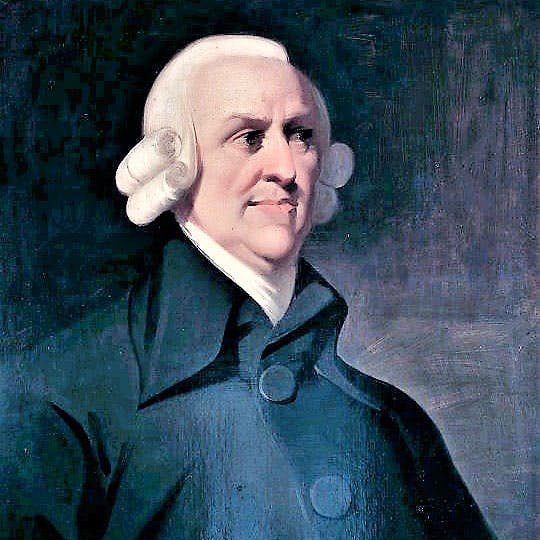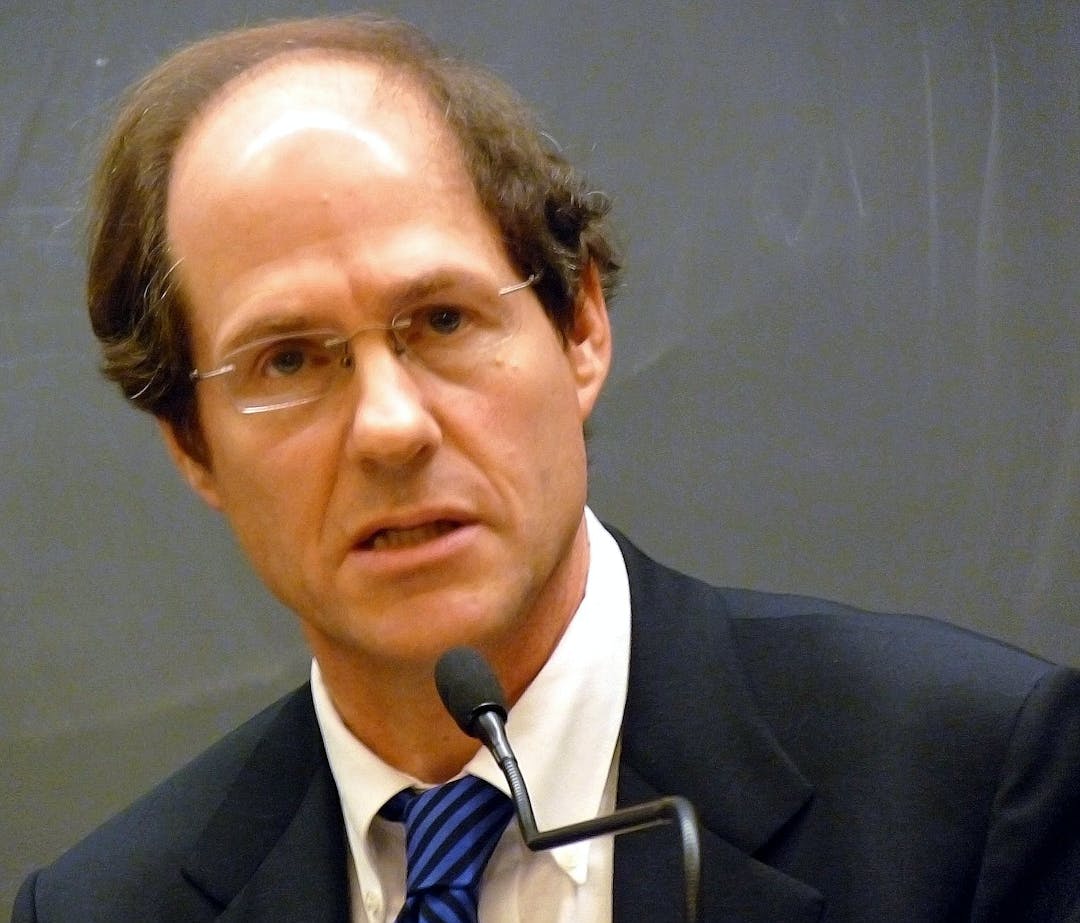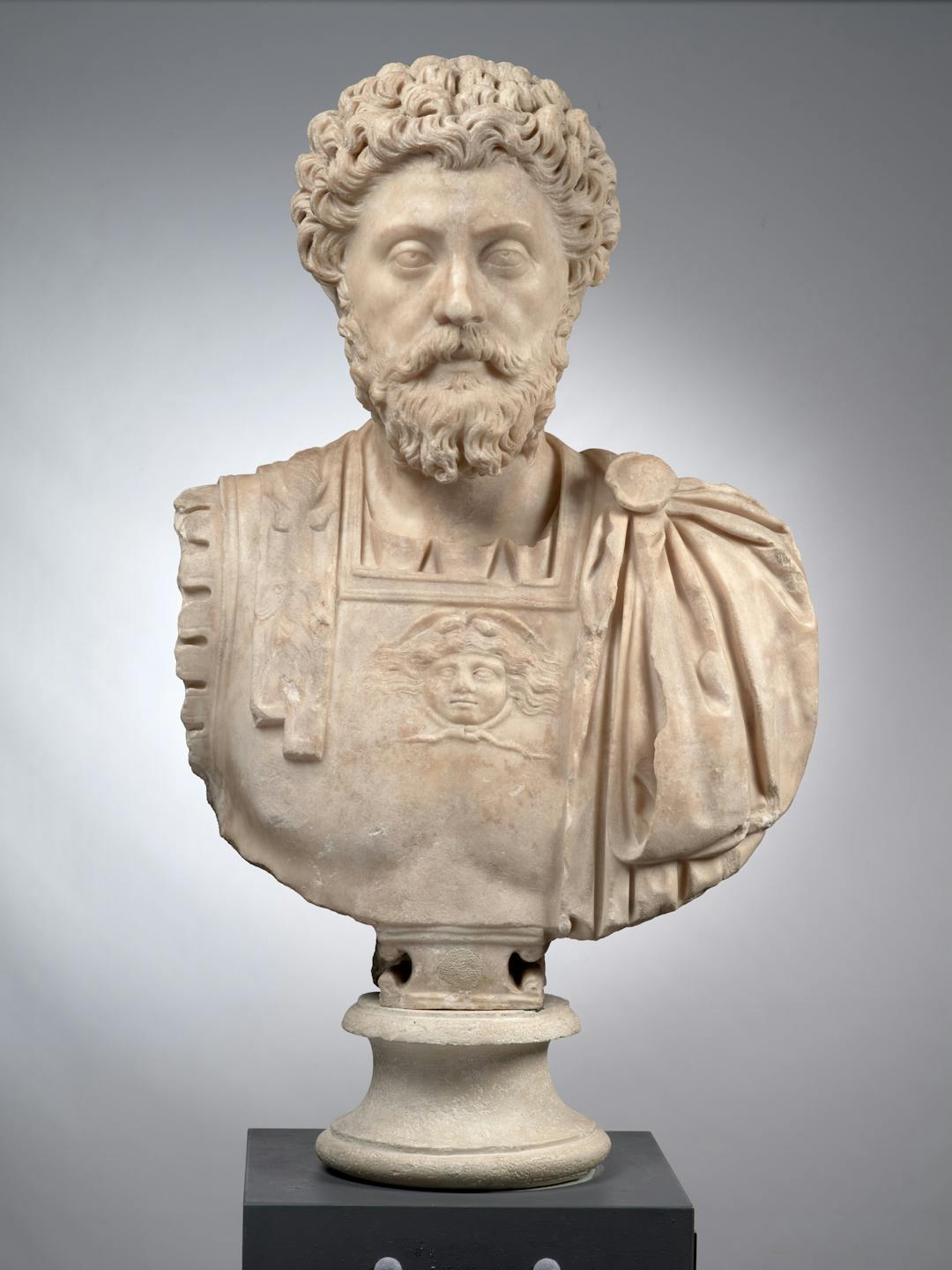Adam Smith
Political Economist and Moral Philosopher
Intro
Adam Smith is regarded as the father of modern economics thanks to his development of a multitude of foundational economic theories and concepts on which the discipline was built. Some of his most influential contributions include division of labor, gross domestic product (GDP), and the theory of the invisible hand.
While Smith is known principally as an economist, he also made notable contributions to the fields of philosophy and psychology, and even wrote a comprehensive history of the field of astronomy. In his 67 years, Smith created a remarkable legacy, which has shaped the way we think and the way our society functions.
It is not from the benevolence of the butcher, the brewer, or the baker, that we expect our dinner, but from their regard to their own interest. We address ourselves, not to their humanity but to their self-love, and never talk to them of our necessities but of their advantages.
– Adam Smith in his book An Inquiry into the Nature and Causes of the Wealth of Nations
On their shoulders
For millennia, great thinkers and scholars have been working to understand the quirks of the human mind. Today, we’re privileged to put their insights to work, helping organizations to reduce bias and create better outcomes.
Invisible hand - Justification for a laissez-faire economic system
The invisible hand is a metaphor used by Smith to elucidate the ties between individual and public interest; specifically, the exchange of money between individuals in the name of their own self-interest has an unintentional, but inevitable, impact on the economy as a whole. Smith’s first use of the metaphor is in his essay, The History of Astronomy, where he describes it as a catchall explanation used by people to explain phenomena they do not understand. Smith used the metaphor again in An Inquiry into the Nature and Causes of the Wealth of Nations (usually referred to as The Wealth of Nations), but this time, he applies it to the economy. Here, he uses it as a means of illustrating how the economy tends to self-regulate.
An example to better illustrate the metaphor of the invisible hand, as he intended it, comes from The Wealth of Nations. He explains that we purchase goods from the butcher, the brewer, and the baker out of our own self-interest, and they sell us these goods out of their own self-interest. Smith was in favor of trusting the system, not manipulating it. He argued that by allowing individuals to make financial decisions with the goal of bettering themselves, we unintentionally improve the economy and society at large.1 In the cases of the butcher, the baker, and the brewer, each purchase benefits parties all the way up the supply chain, even if the consumers bought the product simply to please themselves.
Since Smith’s time, the metaphor has been generalized beyond its original use. The idea now is that supply and demand work to regulate the market on their own. It is used as an argument against government intervention in the economy and as a support for a laissez-faire – or “hands off” – economic system. Modern theorists have extrapolated off of Smith’s metaphor, drawing their own conclusions based on their interpretations of it. These extrapolations, along with Smith’s original theory, are used as justifications for free market capitalism.2
“He generally, indeed, neither intends to promote the public interest, nor knows how much he is promoting it. By preferring the support of domestic to that of foreign industry, he intends only his own security; and by directing that industry in such a manner as its produce may be of the greatest value, he intends only his own gain, and he is in this, as in many other cases, led by an invisible hand to promote an end which was no part of his intention. Nor is it always the worse for the society that it was not part of it. By pursuing his own interest he frequently promotes that of the society more effectually than when he really intends to promote it.”
― Adam Smith in his book An Inquiry into the Nature and Causes of the Wealth of Nations
Sympathy - We develop a conscience by observing the behaviors of others
In The Theory of Moral Sentiments, Smith argued that our decisions and behaviors are dictated by our conscience, which is developed through our judgements of the behaviors of others. These judgements expand our self-awareness, allowing us to understand how our behaviors are perceived by those around us, thereby giving rise to our conscience. Smith referred to this as sympathy. Moral philosophy was Smith’s primary focus in academia, and he arrived at this theory while attempting to understand how humans develop the capacity for moral judgement. Smith felt that reason alone was not enough to explain human behavior; he believed that our perceptions of others’ actions heavily contribute to our own decision-making.
“The first thing you have to know is yourself. A man who knows himself can step outside himself and watch his own reactions like an observer.”
― Adam Smith in his book The Money Game
Suppose that your friend John has won an award and is bragging about it in a way that is insensitive to everyone they beat out for it, including you. You might be hurt by this behavior and judge it as rude. If, at another occasion, you happen to receive an award, you may feel pride in your accomplishment, and want to share that with others – and rightly so. However, in the back of your mind, you’ll remember John and his inconsiderate behavior. This will lead you to adjust your own behavior, so that you act the part of a gracious winner; someone who is clearly happy but is also humble and respectful to everyone else who was in the running for the prize. This is an example of how Smith believed the human conscience develops.
It is not Smith’s theory of sympathy itself that is so influential, it is the idea behind the theory that is his real legacy here. This is actually one of the earliest theories of social psychology, a discipline that did not even really exist during Smith’s lifetime. Smith’s use of the term “sympathy” is outdated – the definition he attributed to it is more closely related to “empathy” – and the theory itself is a rather reductionist approach to the complex processes of human motivation and behavior, yet his innovation made way for future progress in this line of study.
“Every faculty in one man is the measure by which he judges of the like faculty in another. I judge of your sight by my sight, of your ear by my ear, of your reason by my reason, of your resentment by my resentment, of your love by my love. I neither have, nor can have, any other way of judging about them.”
― Adam Smith in his book The Theory of Moral Sentiments
Division of labor - Specialization of labor as the key to wealth
One of Smith’s most influential innovations was the concept of the division of labor. Smith was active at the start of the Industrial Revolution in Europe, a time when mass production in factory settings was starting to take off. He by no means the first to propose this idea, however, he did offer further insight and elaborate on it. Smith considered division of labor to be the key to economic growth, and focused much of The Wealth of Nations on examining the kinds of systems and institutions that would allow for division of labor and, thereby, economic growth – specifically, free market systems.3 Smith believed that productivity could be significantly increased if employees specialized in different areas and each worked exclusively on a single step of a multi-step task. Take, for example, an assembly line. As a product is being assembled, it makes several stops down the line, each time at a different employee. Every employee is given a specific task in the production of this item. By the time the product reaches the end of the assembly line, it is complete.
“Science is the great antidote to the poison of enthusiasm and superstition.”
― Adam Smith in his book An Inquiry into the Nature and Causes of the Wealth of Nations
Division of labor eliminated the need for factory workers to switch tasks throughout their workday. Moreover, this led workers to become experts at their tasks. The result was more efficient production.4 In turn, this led to the progression of industrialization, which gave rise to a multitude of different technological advancements. Additionally, it was yet another step towards a capitalist society.
Although he stated that division of labor was an effective way to increase productivity, Smith was foresighted enough to have concerns over its effects on workers. Specifically, he was worried about the harsh working conditions, and the effect the monotony of performing the same task repeatedly, all day long, would have on them. This was a remarkably progressive stance on his part. He suggested that factory owners offer education to their workers, in hope that it would mitigate the negative effects of their working conditions.5 Unfortunately, his suggestions were ignored and factory conditions remained abhorrent throughout the many waves of the Industrial Revolution.
“The man of system…is apt to be very wise in his own conceit; and is often so enamoured with the supposed beauty of
his own ideal plan of government, that he cannot suffer the smallest deviation from any part of it… He seems to imagine that he can arrange the different members of a great society with as much ease as the hand arranges the different pieces upon a chess-board. He does not consider that in the great chess-board of human society, every single piece has a principle of motion of its own, altogether different from that which the legislature might choose to impress upon it.”
― Adam Smith in his book The Theory of Moral Sentiments
Historical Biography
Adam Smith is originally from Kirkcaldy, Scotland. His exact date of birth is not known, but the year is often cited as 1723, as that was when he was baptized.6 At the age of 14, he enrolled at the University of Glasgow, where he studied moral philosophy under Francis Hutcheson. Upon graduating, he continued his study of philosophy at Balliol College at Oxford University. Before taking up a professorship at the University of Glasgow, Smith gave a series of public lectures in Edinburgh. These lectures covered a variety of subjects, including rhetoric, history, and economics, all of which Smith would revisit throughout his career. Smith began his time as a professor lecturing on logic, but soon expanded his repertoire to include other topics, such as ethics and political economy.7
Smith published The Wealth of Nations in 1776. Of his many innovations, the ones put forth in this book are arguably his most recognizable. This text is regarded as the foundation off of which the field of modern economics was built. It had a significant impact on economic thought, as it explored the free market and the laissez-faire ideology from both a philosophical and a sociological perspective.8 At the time Smith was working on this book, the mercantilist economic system was being phased out in favor of capitalism.9 The Wealth of Nations was aptly timed, with its clear “out with the old, in with the new” stance on this matter. Smith was a clear proponent for a laissez-faire economic approach and did not hide his distaste for mercantilism. Furthermore, the European Industrial Revolution was underway, making Smith’s introduction of the concepts like division of labor, and discussions of topics like productivity, particularly pertinent.
“The man whose whole life is spent in performing a few simple operations, of which the effects are perhaps always the same, or very nearly the same, has no occasion to exert his understanding or to exercise his invention in finding out expedients for removing difficulties which never occur. He naturally loses, therefore, the habit of such exertion, and generally becomes as stupid and ignorant as it is possible for a human creature to become.”
― Adam Smith in his book An Inquiry into the Nature and Causes of the Wealth of Nations
Aside from his contributions to economics and philosophy, Smith was one of the forerunners of social psychology. Psychology was not truly established as a scientific discipline until the mid-nineteenth century, yet Smith’s 1759 book, The Theory of Moral Sentiments, tackled topics that would today be considered areas of interest in social psychology. Specifically, Smith was interested in what motivates human behavior.
Many historians are interested in Smith’s close friendship with fellow Scottish Enlightenment philosopher, David Hume. Part of why this relationship is so fascinating is that Hume was such a controversial figure in moral philosophy. This controversy stemmed from his claim that human behavior results not from reason, but from passion.10 Put simply, our intellect gives us the ability to distinguish between right and wrong, but our actions are ultimately determined by our emotions. While the two men did not collaborate on any major works, Smith’s moral philosophy text, The Theory of Moral Sentiments, shows clear traces of Hume’s influence.11
“Never complain of that of which it is at all times in your power to rid yourself.”
― Adam Smith in his book The Theory of Moral Sentiments
Published Works
The Theory of Moral Sentiments
Smith’s first published work acts as a precursor to his magnum opus, An Inquiry into the Nature and Causes of the Wealth of Nations. In this book, he explores the means through which humankind develops the capacity for moral judgement. Here, he develops his theory of sympathy, which posits that by observing the people around us and the judgements they form about their own behavior and that of others, we are able to achieve self-awareness, which gives rise to our conscience.
Also known as Lectures on Justice, Police, Revenue and Arms, this book is a compilation of Smith’s lecture notes from his time as a professor at the University of Glasgow in the 1760s. His lectures were mainly focused on his theory of civil government and how it ought to be directed. This book also includes an early draft of An Inquiry into the Nature and Causes of the Wealth of Nations.
An Inquiry into the Nature and Causes of the Wealth of Nations
Published in 1776, An Inquiry into the Nature and Causes of the Wealth of Nations, often shortened to The Wealth of Nations, is regarded as Smith’s most influential work and is a cornerstone text of classical economics. It is here that he introduces the renowned concept of the invisible hand. This book was written at the start of the first Industrial Revolution in Europe and, with this setting as a backdrop, it explores themes such as productivity, free markets, and the division of labor.
Essays on Philosophical Subjects
Split into three parts, “The History of Astronomy”, “The History of Ancient Physics”, and “The History of Ancient Logics and Metaphysics”, Smith’s Essays on Philosophical Subjects was published posthumously. “The History of Astronomy” is the longest of the three sections, and is well-regarded for its comprehensive detailing of the field of astronomy up to the mid-eighteenth century. While The Wealth of Nations was published prior to the release of this book, “The History of Astronomy” is believed to have been written before it. This is particularly noteworthy, as “The History of Astronomy” contains a reference to the invisible hand, one of Smith’s most influential concepts, making this the first recorded mention of it.
Adam Smith: What He Thought, and Why it Matters
In this biography, Jesse Norman looks at Adam Smith as more than just the Father of Modern Economics. He explores Smith’s ideas about economics, certainly, but he also explores Smith’s views on law, ethics, government, psychology, and behavior theory and how these ideas have influenced society over the past two centuries.
The Infidel and the Professor: David Hume, Adam Smith, and the Friendship that Shaped Modern Thought
Dennis C. Rassmussen’s account of the friendship between Adam Smith and philosopher David Hume is a fascinating look into how these two men influenced modern thought. It examines them separately and together and provides insight into their legacies and how they continue to impact us to this day.
References
- Weinstein, J.R. “Adam Smith”. Internet Encyclopedia of Philosophy. https://iep.utm.edu/smith/#H1
- Majaski, C. (2019). “Invisible Hand Definition”. Investopedia. https://www.investopedia.com/terms/i/invisiblehand.asp
- Chandra, R. (2004). Adam Smith, Allyn Young, and the Division of Labor. Journal of Economic Issues, 38(3), 787-805. Retrieved August 15, 2020, from www.jstor.org/stable/4228057
- Dhamee, Y. (1995). “Adam Smith and the Division of Labor”. The Victorian Web. http://www.victorianweb.org/economics/division.html
- See 4
- “Adam Smith Biography”. (2019). Biography. https://www.biography.com/scholar/adam-smith
- Heilbroner, R.L. (2020). “Adam Smith”. Encyclopaedia Britannica. https://www.britannica.com/biography/Adam-Smith
- See 1
- Blenman, J. (2020). “Adam Smith and The Wealth of Nations”. Investopedia. https://www.investopedia.com/updates/adam-smith-wealth-of-nations/
- See 1
- Rasmussen, D.C. (2018) “The Infidel and the Professor: The Friendship of Adam Smith and David Hume.” Adam Smith Works. https://www.adamsmithworks.org/life_times/the-infidel-and-the-professor-the-friendship-of-adam-smith-and-david-hume
About the Author
The Decision Lab
The Decision Lab is a Canadian think-tank dedicated to democratizing behavioral science through research and analysis. We apply behavioral science to create social good in the public and private sectors.





